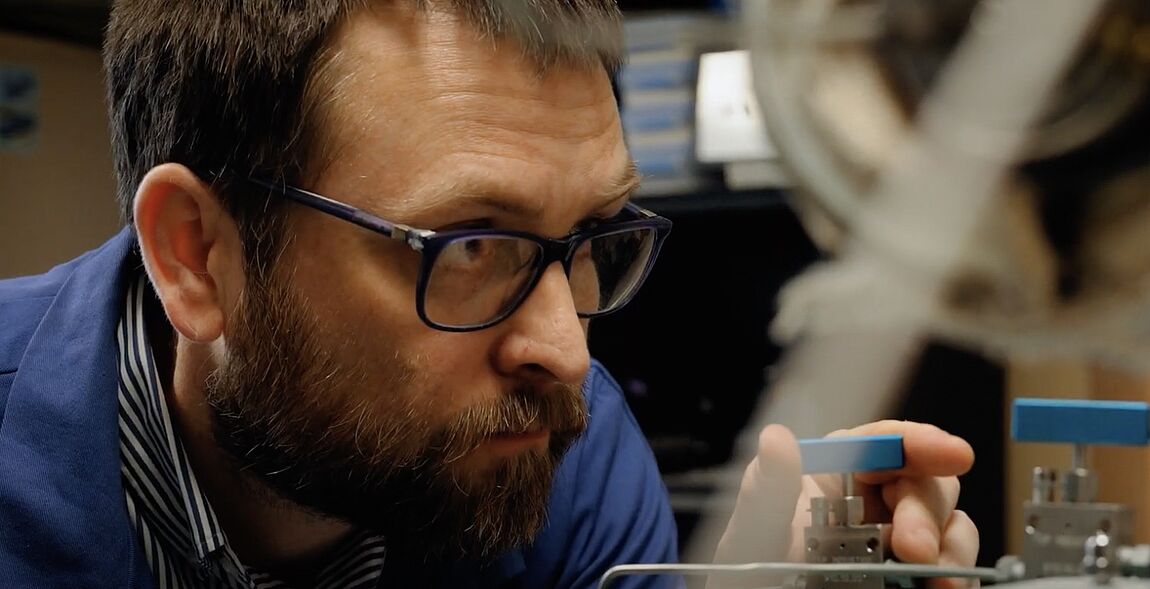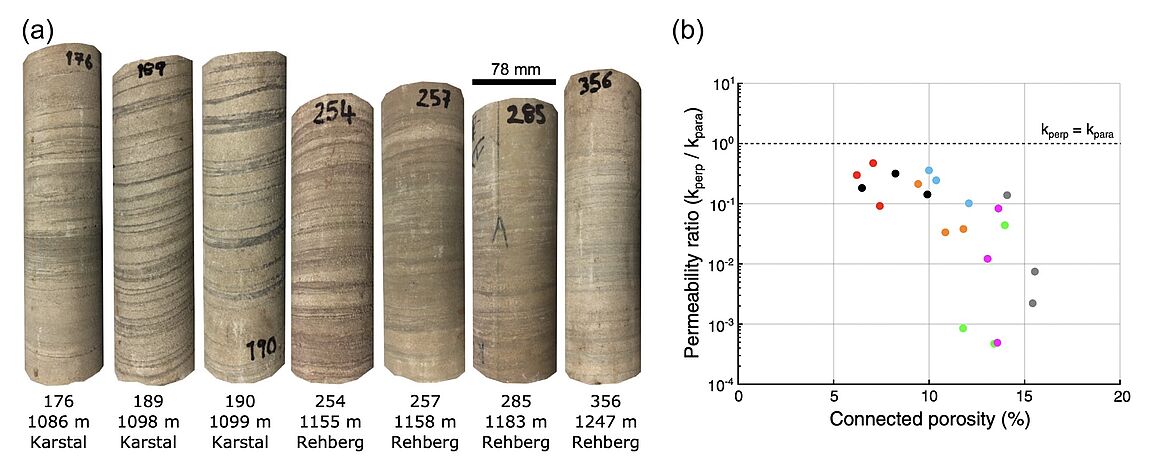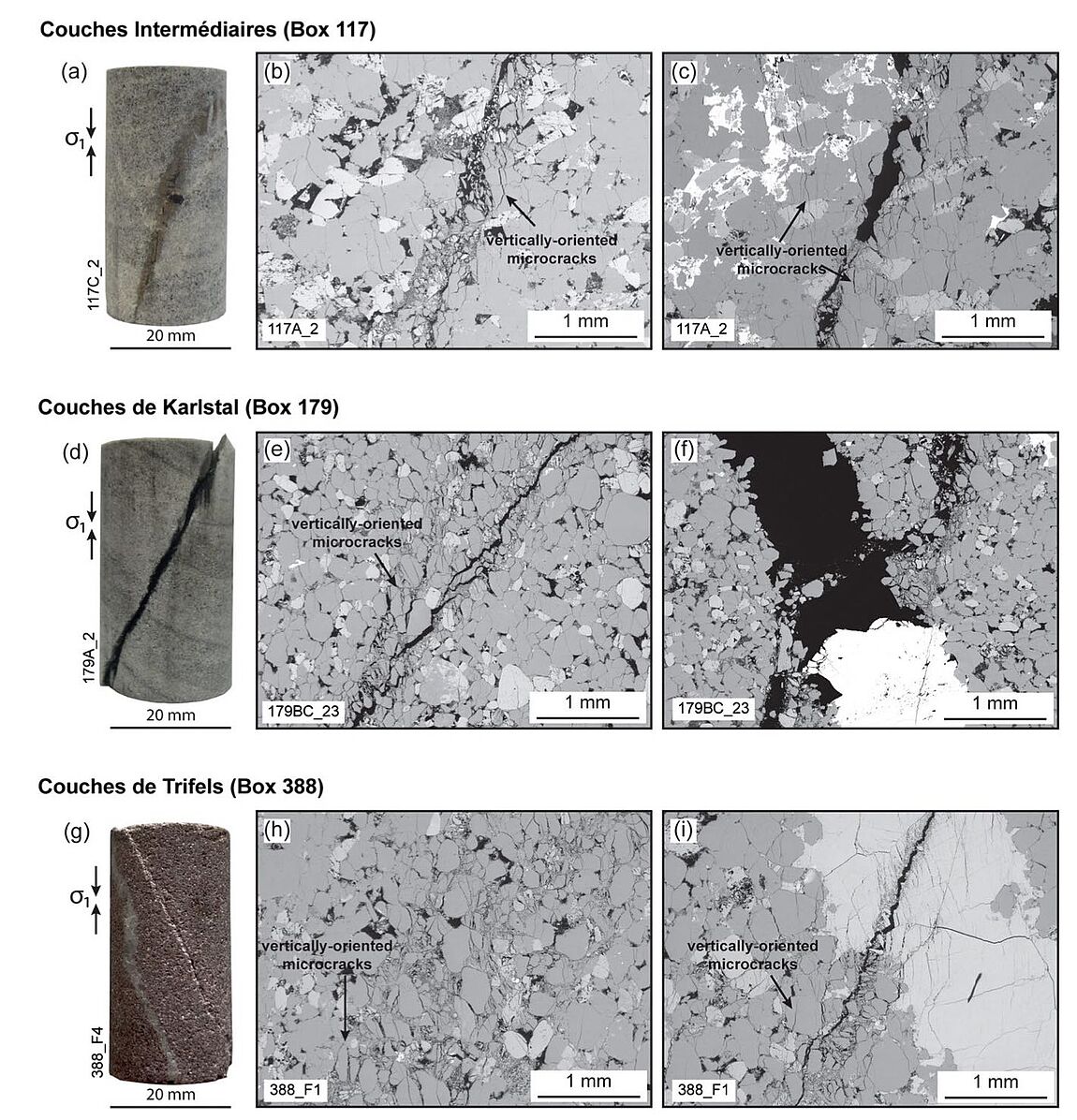The main focus of the "rock physics and geomechanics" working group is to provide laboratory data on the mechanical, physical, and hydraulic properties of rocks to better understand topics related to the energy transition. To do so, it uses a variety of purpose-built equipment at the Strasbourg Institute of Earth & Environment (ITES) designed to investigate the deformation behaviour and fluid flow properties of the Earth's crust.
Achievements
WG4 has been very productive since the start of the ITI GeoT project. It has published several papers in peer-reviewed journals on the topic of the energy transition, it has won several international and collaborative grants focused on geothermal energy exploitation, and it has gained many new national and international collaborators.
Although, it is yet to delve deeply into experiments designed to investigate CO2 sequestration, the groups has published two papers that focus on rock-fluid interactions: "Influence of water on deformation and failure of gypsum rock" and "Effect of water on sandstone's fracture toughness and frictional parameters: Brittle strength constraints". In 2024, more potential experiments and collaboration related to CO2 sequestration and rock-fluid interactions are to be develop with the Norwegian Geotechnical Institute.
The group goal to explore volcano-geothermal and the geothermal potential of fault zones progressed very well. Regarding volcano-geothermal, WG4 won a Hubert Curien Partnership (PHC) ULYSSES collaborative grant with researchers in Ireland to study "Renewable energy extraction from volcanoes: Exploring the geothermal potential of volcanic calderas" in 2021 and, in 2022, it published a paper entitled "Geothermal potential of small sub-volcanic intrusions in a typical Icelandic caldera setting".
Regarding the geothermal potential of crustal fault zones, WG4 won an ANR grant worth 798 k€, led by the BRGM, to study "Geothermal resources of crustal fault zones: exploring new systems for competitive geothermal power production" (GERESFAULT). In this framework, a postdoc was hired. On a similar topic, WG4 also won, with our colleagues from the Geological Survey of Finland, an Academy of Finland grant worth 999 k€ to study "Discovering deep geothermal resources in low-enthalpy crystalline settings" in 2023. In the framework of this grant, the group published a paper, also in 2023, entitled "Hydrothermally altered shear zones: a new reservoir play for the expansion of deep geothermal exploration in crystalline settings".
Finally, the WG4 has continued to work on local geothermal energy exploitation in the Upper Rhine Graben, resulting in the publication of two papers ("Reactivation of variably sealed joints and permeability enhancement in geothermal reservoir rocks" and "Permeability anisotropy in sandstones from the Soultz-sous-Forêts geothermal reservoir (France): implications for large-scale fluid flow modelling").
Figure 1. (a) Photographs of cores of laminated Buntsandstein sandstones taken from EPS-1 borehole at Soultz-sous-Forêts (France). (b) Graph of permeability ratio (permeability perpendicular to bedding divided by permeability parallel to bedding) as a function of porosity for the core samples shown in panel (a). The graph shows that all the laminated sandstones are characterised by a permeability anisotropy. Figures from Goupil et al. (2022).
Figure 2. (a, d, and g) Photographs of deformed cores of Buntsandstein sandstones taken from EPS-1 borehole at Soultz-sous-Forêts (France) containing partially-filled or filled joints. Samples were deformed under triaxial conditions. (b, c, e, f, h, and i) Scanning electron microscope (SEM) images of the deformed samples showing the relationship between the partially-filled or filled joints and the fracture that formed in the sample following the deformation. Figures from Kushnir et al. (2023).
Figure 3. (a) Stratigraphic column showing the Buntsandstein Formation (anté-Annweiler to Voltzia) and the granite reservoir below. Adjacent to the column is the fracture density from the borehole (in red). (b) Upscaled compressive strength of the Buntsandstein Formation and granite reservoir in both wet (black line) and dry (dashed grey line) conditions. Figures from Heap et al. (2019).

Team
Leader: Michael Heap (ITES)
- Members (EOST/ITES): Patrick Baud, Thierry Reuschlé, Bertrand Renaudie
- Post-doc: Lucille Carabillet (2023-2024)
- PhD candidates: Sarvar Mammadov, Kamal Bayramov, Jalileh Nasseri
Collaborations
With the other ITI GeoT WGs:
WG3: Potential methods
WG6: Geology
With other academic partners:
M. Violay (EPSL, Switzerland)
A. Kushnir (EPFL, Switzerland)
N. Brantut (UCL, UK)
A. Bishoff Geological Survey of Finland
L. Griffiths (Norwegian Geotechnical Institute Olso, Norway)
F. Renard (University of Oslo, Norway)
T-F. Wong (University of Hong Kong, Hong Kong)
F. Meng (Sun Yat-sen University Zhuhai, China)
Northeastern University Shenyang, China)
With socio-economic partners:
BRGM, Orléans
Publications
Creep Properties and Transient Strength Enhancement of Sandstone in Acidic versus Distilled Water: Mechanisms of Precipitation Sealing. Xue, Y. Xu, T., Heap, M.J., Sun, W., Liu Y., Liu Z. (2025).Construction and Building Materials. https://doi.org/10.1016/j.conbuildmat.2025.144645
Decrease in the Permeability of Microcracked and Macrocracked Granite at Elevated Pressure and Temperature. L. Carbillet, M. J. Heap, P. Baud, J. I. Farquharson (2025). Geophysical Research Letters. https://doi.org/10.1029/2024GL112970
Time-Dependent Deformation of Sandstone due to Chemical Corrosion: An Investigation Using the Heterogeneous Grain-Based Phase-Field Method. Bin Xu, Tao Xu, Shigui Du, Michael Heap, Alexandra Kushnir, et al. (2025). Rock Mechanics and Rock Engineering. https://doi.org/10.1007/s00603-025-04439-2
Development of Permeability Heterogeneity During Compaction of Porous Sandstone. Nicolas Brantut, Patrick Baud (2025). JGR Solid Earth. https://doi.org/10.1029/2024JB030022
Onset of pore collapse and dilatancy in porous sandstone under true triaxial compression: Experimental observation and micromechanical modeling. Meng, F., Shi, L., Hall, S., Baud, P., & Wong, T. F. (2025). International Journal of Rock Mechanics and Mining Sciences. https://doi.org/10.1016/j.ijrmms.2024.105983
Sedimentary control on permeability heterogeneity: the Middle Buntsandstein continental sandstones (Lower Triassic, eastern France). Lucas Bofill, Guilherme Bozetti, Gerhard Schäfer, Jean-François Ghienne, Mathieu Schuster, Mike Heap, Gabriela Knobelock, Claiton Scherer, Garibaldi Armenlenti, Ezequiel de Souza (2025). Marine and Petroleum Geology. https://doi.org/10.1016/j.marpetgeo.2024.107261
Water weakening and the compressive brittle strength of carbonates: Influence of fracture toughness and static friction. Corentin Noël, Barnaby Fryer, Patrick Baud, Marie Violay (2024). International Journal of Rock Mechanics and Mining Sciences. https://dx.doi.org/10.1016/j.ijrmms.2024.105736
The Influence of Micro- and Macrocracks on the Permeability of Granite. L. Carbillet, L. Griffiths, M. J. Heap, H. Duwiquet, P. Baud, M. E. S. Violay, T. Reuschlé & L. Guillou-Frottier (2024). Rock Mechanics and Rock Engineering. https://doi.org/10.1007/s00603-024-04174-0
Physical and mechanical depth relationships of rocks from the Rotokawa Geothermal Reservoir, Taupō Volcanic Zone, New Zealand. Marlène C. VilleneuveORCID Icon,Timothy P.C. Jones,Michael J. Heap,Ben M. Kennedy,Jim W. Cole &Paul A. Siratovich (2024). New Zealand Journal of Geology and Geophysics. https://doi.org/10.1080/00288306.2024.2424847
Compaction and Permeability Evolution of Tuffs From Krafla Volcano (Iceland). Michael J. Heap, Kamal Bayramov, Gabriel G. Meyer, Marie E. S. Violay, Thierry Reuschlé, Patrick Baud, H. Albert Gilg, Claire E. Harnett, Alexandra R. L. Kushnir, Francesco Lazari, Anette K. Mortensen (2024). JGR Solid Earth. https://doi.org/10.1029/2024JB029067
The influence of temperature (up to 120 °C) on the thermal conductivity of variably porous andesite. Michael J. Heap, Gunel Alizada, David E. Jessop, Ben M. Kennedy, Fabian B. Wadsworth (2024). Journal of Volcanology and Geothermal research. https://doi.org/10.1016/j.jvolgeores.2024.108140
Thermal Stressing of Volcanic Rock: Microcracking and Crack Closure Monitored Through Acoustic Emission, Ultrasonic Velocity, and Thermal Expansion.. L. Griffiths, M. J. Heap, O. Lengliné, P. Baud, J. Schmittbuhl, H. A. Gilg (2024). JGR Solid. https://doi.org/10.1029/2023JB027766
Hydrothermally altered shear zones: A new reservoir play for the expansion of deep geothermal exploration in crystalline settings. Alan Bischoff, Michael J. Heap, Perttu Mikkola, Jukka Kuva, Thierry Reuschlé, Ester M. Jolis, Jon Engström, Heini Reijonen, Tuomas Leskelä. (2024). Geothermics. https://doi.org/10.1016/j.geothermics.2023.102895
Effect of pH on primary and secondary crack propagation in sandstone under constant stress (creep) loading. Yanchao Xue, Tao Xu, Michael J. Heap, Wancheng Zhu, P.G. Ranjith, Zhiguo Li. (2024). Construction and Building Materials. https://doi.org/10.1016/j.conbuildmat.2024.135727
Reactivation of variably sealed joints and permeability enhancement in geothermal reservoir rocks. Kushnir, A.R.L., Heap, M.J., Baud, P., Reuschlé, T., and Schmittbuhl, J.. (2023). Geothermal Energy. https://doi.org/10.1186/s40517-023-00271-5
The Permeability of Porous Volcanic Rock Through the Brittle-Ductile Transition. Michael J. Heap, Gabriel G. Meyer, Corentin Noël, Fabian B. Wadsworth, Patrick Baud, Marie E. S. Violay. (2022). JGR Solid Earth. https://doi.org/10.1029/2022JB024600
Permeability anisotropy in sandstones from the Soultz-sous-Forêts geothermal reservoir (France): implications for large-scale fluid flow modelling. Margaux Goupil, Michael J. Heap, Patrick Baud. (2022). Geothermal Energy. https://doi.org/10.1186/s40517-022-00243-1
Influence of water on deformation and failure of gypsum rock. Chiara Caselle, Patrick Baud, Alexandra R.L. Kushnir, Thierry Reuschlé, Sabrina M.R. Bonetto. (2022). Journal of Structural Geology. https://doi.org/10.1016/j.jsg.2022.104722
Geothermal potential of small sub-volcanic intrusions in a typical Icelandic caldera setting. Steffi Burchardt, Mohsen Bazargan, Einar Bessi Gestsson, Christoph Hieronymus, Erika Ronchin, Hugh Tuffen, Michael J. Heap, Jonathan Davidson, Ben M. Kennedy, Alex Hobé and Elodie Saubin. (2022). Volcania. https://doi.org/10.30909/vol.05.02.477507
Effect of water on sandstone's fracture toughness and frictional parameters: Brittle strength constraints. Corentin Noël, Patrick Baud, Marie Violay. (2021). International Journal of Rock Mechanics and Mining Sciences. https://doi.org/10.1016/j.ijrmms.2021.104916
A Numerical Meso-Scale Elasto-Plastic Damage Model for Modeling the Deformation and Fracturing of Sandstone Under Cyclic Loading. Tao Xu, Meng Fu, Sheng-qi Yang, Michael J. Heap & Guang-lei Zhou. (2021). Rock Mechanics and Rock Engineering. https://doi.org/10.1007/s00603-021-02556-2




